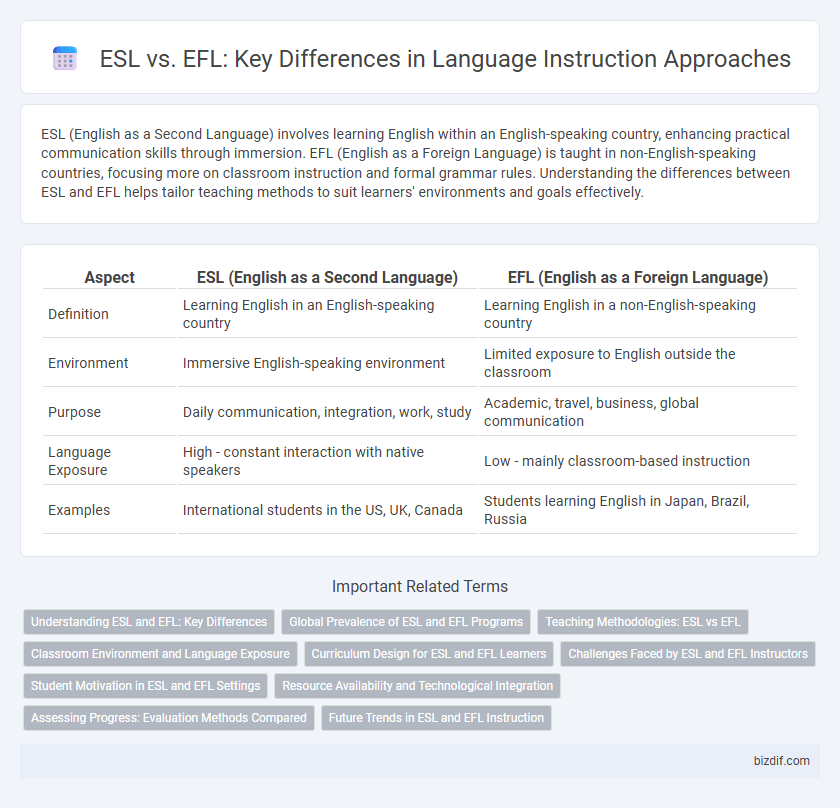ESL (English as a Second Language) involves learning English within an English-speaking country, enhancing practical communication skills through immersion. EFL (English as a Foreign Language) is taught in non-English-speaking countries, focusing more on classroom instruction and formal grammar rules. Understanding the differences between ESL and EFL helps tailor teaching methods to suit learners' environments and goals effectively.
Table of Comparison
| Aspect | ESL (English as a Second Language) | EFL (English as a Foreign Language) |
|---|---|---|
| Definition | Learning English in an English-speaking country | Learning English in a non-English-speaking country |
| Environment | Immersive English-speaking environment | Limited exposure to English outside the classroom |
| Purpose | Daily communication, integration, work, study | Academic, travel, business, global communication |
| Language Exposure | High - constant interaction with native speakers | Low - mainly classroom-based instruction |
| Examples | International students in the US, UK, Canada | Students learning English in Japan, Brazil, Russia |
Understanding ESL and EFL: Key Differences
ESL (English as a Second Language) refers to teaching English to non-native speakers living in an English-speaking country, emphasizing practical communication and cultural immersion. EFL (English as a Foreign Language) targets learners studying English in non-English-speaking countries, focusing on language skills within a classroom setting without immediate cultural exposure. Understanding these distinctions helps educators tailor instruction methods to meet learners' specific linguistic and environmental needs.
Global Prevalence of ESL and EFL Programs
ESL (English as a Second Language) programs dominate in countries where English is the primary language, such as the United States, Canada, and the United Kingdom, serving immigrants and international students. EFL (English as a Foreign Language) programs are prevalent in non-English-speaking countries like China, Japan, and Brazil, where English is taught primarily as an academic subject. Globally, the demand for both ESL and EFL instruction reflects the increasing importance of English for international communication, business, and education.
Teaching Methodologies: ESL vs EFL
ESL teaching methodologies emphasize immersive, communicative approaches tailored to students using English in real-life contexts, promoting practical language skills through interactive activities and contextual learning. EFL instruction often relies on structured, grammar-focused techniques designed for classroom settings where English is a foreign language, prioritizing accuracy and formal language knowledge. Both approaches integrate multimedia resources and task-based learning, yet ESL methods typically prioritize fluency and cultural adaptation more intensely.
Classroom Environment and Language Exposure
ESL classrooms immerse students in environments where English is the primary language of communication, providing constant exposure that fosters natural language acquisition. In contrast, EFL settings often lack daily English interaction outside the classroom, limiting students' practical language exposure to structured lessons. This difference significantly impacts learners' fluency development and confidence in real-world English usage.
Curriculum Design for ESL and EFL Learners
Curriculum design for ESL learners emphasizes real-life communication skills and cultural integration within an immersive English-speaking environment, focusing on practical usage and social interaction. EFL curriculum, by contrast, prioritizes structured grammar, vocabulary building, and reading and writing skills tailored for learners studying English in non-English-speaking countries. Effective ESL and EFL programs balance linguistic proficiency with cultural context to address learner needs and optimize language acquisition outcomes.
Challenges Faced by ESL and EFL Instructors
ESL instructors often encounter diverse linguistic and cultural backgrounds in immersive environments, leading to challenges in addressing varying proficiency levels and real-life communication skills. EFL instructors face obstacles such as limited exposure to the target language outside the classroom, which affects student motivation and practical language use. Both groups struggle with adapting teaching methodologies to meet the unique needs of learners in different contexts, requiring continuous professional development and resourcefulness.
Student Motivation in ESL and EFL Settings
Student motivation in ESL (English as a Second Language) settings is often driven by immediate practical needs such as integration, employment, and social communication, which enhances engagement through real-life application. In EFL (English as a Foreign Language) contexts, motivation tends to be more intrinsic or exam-oriented, influenced by academic goals or future career aspirations rather than everyday necessity. Understanding these motivational differences allows educators to tailor instructional strategies, leveraging contextual relevance and goal-setting to maximize language acquisition efficiency.
Resource Availability and Technological Integration
ESL learners benefit from greater resource availability due to immersion in English-speaking environments, with access to authentic language materials and interactive technology like language apps and multimedia tools. EFL contexts often face limitations in technological integration, relying predominantly on textbooks and structured lessons without extensive exposure to native speakers or real-world usage. Enhanced digital platforms and online resources are increasingly bridging this gap, offering EFL students innovative opportunities to practice listening, speaking, and cultural comprehension.
Assessing Progress: Evaluation Methods Compared
ESL (English as a Second Language) assessment methods emphasize real-time, immersive evaluation through continuous oral and written performance in a predominantly English-speaking environment. EFL (English as a Foreign Language) typically relies on standardized tests, grammar exercises, and controlled classroom assessments to gauge progress in contexts where English is not the primary language. Both approaches utilize formative and summative evaluations, but ESL assessments prioritize adaptive feedback based on practical language use, while EFL assessments often focus on measurable linguistic accuracy and rule mastery.
Future Trends in ESL and EFL Instruction
Future trends in ESL and EFL instruction emphasize the integration of advanced technologies such as artificial intelligence and virtual reality to create immersive language learning environments. Personalized learning platforms harness data analytics to tailor instruction to individual student needs, enhancing engagement and outcomes. The growing emphasis on intercultural competence prepares learners to navigate global communication challenges effectively.
ESL vs EFL Infographic

 bizdif.com
bizdif.com